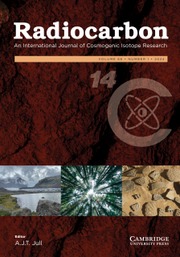Crossref Citations
This article has been cited by the following publications. This list is generated based on data provided by
Crossref.
Bronić, Ines Krajcar
Horvatinčić, Nada
Srdoč, Dušan
and
Obelić, Bogomil
1992.
Experimental Determination of the 14C Initial Activity of Calcareous Deposits.
Radiocarbon,
Vol. 34,
Issue. 3,
p.
593.
Pazdur, Anna
Pazdur, Mieczysław F.
Pawlyta, Jacek
Górny, Andrzej
and
Olszewski, Michał
1995.
Paleoclimatic Implications of Radiocarbon Dating Of Speleothems from the Cracow-Wieluń Upland, Southern Poland.
Radiocarbon,
Vol. 37,
Issue. 2,
p.
103.
Duliński, M.
Grabczak, J.
Kostecka, A.
and
Wȩcławik, S.
1995.
Stable isotope composition of spelean calcites and gaseous CO2 from Tylicz (Polish Carpathians).
Chemical Geology,
Vol. 125,
Issue. 3-4,
p.
271.
Fontes, Jean-Charles
Gasse, Françoise
and
Gibert, Elisabeth
1996.
Holocene environmental changes in Lake Bangong basin (Western Tibet). Part 1: Chronology and stable isotopes of carbonates of a Holocene lacustrine core.
Palaeogeography, Palaeoclimatology, Palaeoecology,
Vol. 120,
Issue. 1-2,
p.
25.
Wachniew, Przemysław
and
Różański, Kazimierz
1997.
Carbon budget of a mid-latitude, groundwater-controlled lake: Isotopic evidence for the importance of dissolved inorganic carbon recycling.
Geochimica et Cosmochimica Acta,
Vol. 61,
Issue. 12,
p.
2453.
Genty, Dominique
and
Massault, Marc
1997.
Bomb 14C Recorded in Laminated Speleothems: Calculation of Dead Carbon Proportion.
Radiocarbon,
Vol. 39,
Issue. 1,
p.
33.
Baker, Andy
Ito, Emi
Smart, Peter L.
and
McEwan, Reed F.
1997.
Elevated and variable values of 13C in speleothems in a British cave system.
Chemical Geology,
Vol. 136,
Issue. 3-4,
p.
263.
Hellstrom, John
McCulloch, Malcolm
and
Stone, John
1998.
A Detailed 31,000-Year Record of Climate and Vegetation Change, from the Isotope Geochemistry of Two New Zealand Speleothems.
Quaternary Research,
Vol. 50,
Issue. 2,
p.
167.
Ku, T. L.
and
Li, H. C.
1998.
Speleothems as high-resolution paleoenvironment archives: Records from northeastern China.
Journal of Earth System Science,
Vol. 107,
Issue. 4,
p.
321.
Genty, Dominique
Massault, Marc
Gilmour, Mabs
Baker, Andy
Verheyden, Sophie
and
Kepens, Eddy
1999.
Calculation of Past Dead Carbon Proportion and Variability by the Comparison of AMS 14C and Tims U/TH Ages on Two Holocene Stalagmites.
Radiocarbon,
Vol. 41,
Issue. 3,
p.
251.
Hellstrom, J.C
and
McCulloch, M.T
2000.
Multi-proxy constraints on the climatic significance of trace element records from a New Zealand speleothem.
Earth and Planetary Science Letters,
Vol. 179,
Issue. 2,
p.
287.
Bottrell, S. H.
Crowley, S.
and
Self, C.
2001.
Invasion of a karst aquifer by hydrothermal fluids: evidence from stable isotopic compositions of cave mineralization.
Geofluids,
Vol. 1,
Issue. 2,
p.
103.
Linge, Henriette
Lauritzen, Stein-Erik
and
Lundberg, Joyce
2001.
Stable Isotope Stratigraphy of a Late Last Interglacial Speleothem from Rana, Northern Norway.
Quaternary Research,
Vol. 56,
Issue. 2,
p.
155.
Linge, H
Lauritzen, S.-E
Lundberg, J
and
Berstad, I.M
2001.
Stable isotope stratigraphy of Holocene speleothems: examples from a cave system in Rana, northern Norway.
Palaeogeography, Palaeoclimatology, Palaeoecology,
Vol. 167,
Issue. 3-4,
p.
209.
Labonne, Maylis
Hillaire-Marcel, Claude
Ghaleb, Bassam
and
Goy, Jose-Luis
2002.
Multi-isotopic age assessment of dirty speleothem calcite: an example from Altamira Cave, Spain.
Quaternary Science Reviews,
Vol. 21,
Issue. 8-9,
p.
1099.
Paulsen, Dorte Eide
Li, Hong-Chun
and
Ku, Teh-Lung
2003.
Climate variability in central China over the last 1270 years revealed by high-resolution stalagmite records.
Quaternary Science Reviews,
Vol. 22,
Issue. 5-7,
p.
691.
Horvatinčić, Nada
Krajcar Bronić, Ines
and
Obelić, Bogomil
2003.
Differences in the 14C age, δ13C and δ18O of Holocene tufa and speleothem in the Dinaric Karst.
Palaeogeography, Palaeoclimatology, Palaeoecology,
Vol. 193,
Issue. 1,
p.
139.
Quade, Jay
2003.
The Quaternary Period in the United States.
Vol. 1,
Issue. ,
p.
205.
Ralska-Jasiewiczowa, M.
Goslar, T.
Różański, K.
Wacnik, A.
Czernik, J.
and
Chróst, L.
2003.
Very fast environmental changes at the Pleistocene/Holocene boundary, recorded in laminated sediments of Lake Gościż, Poland.
Palaeogeography, Palaeoclimatology, Palaeoecology,
Vol. 193,
Issue. 2,
p.
225.
McDermott, Frank
2004.
Palaeo-climate reconstruction from stable isotope variations in speleothems: a review.
Quaternary Science Reviews,
Vol. 23,
Issue. 7-8,
p.
901.

